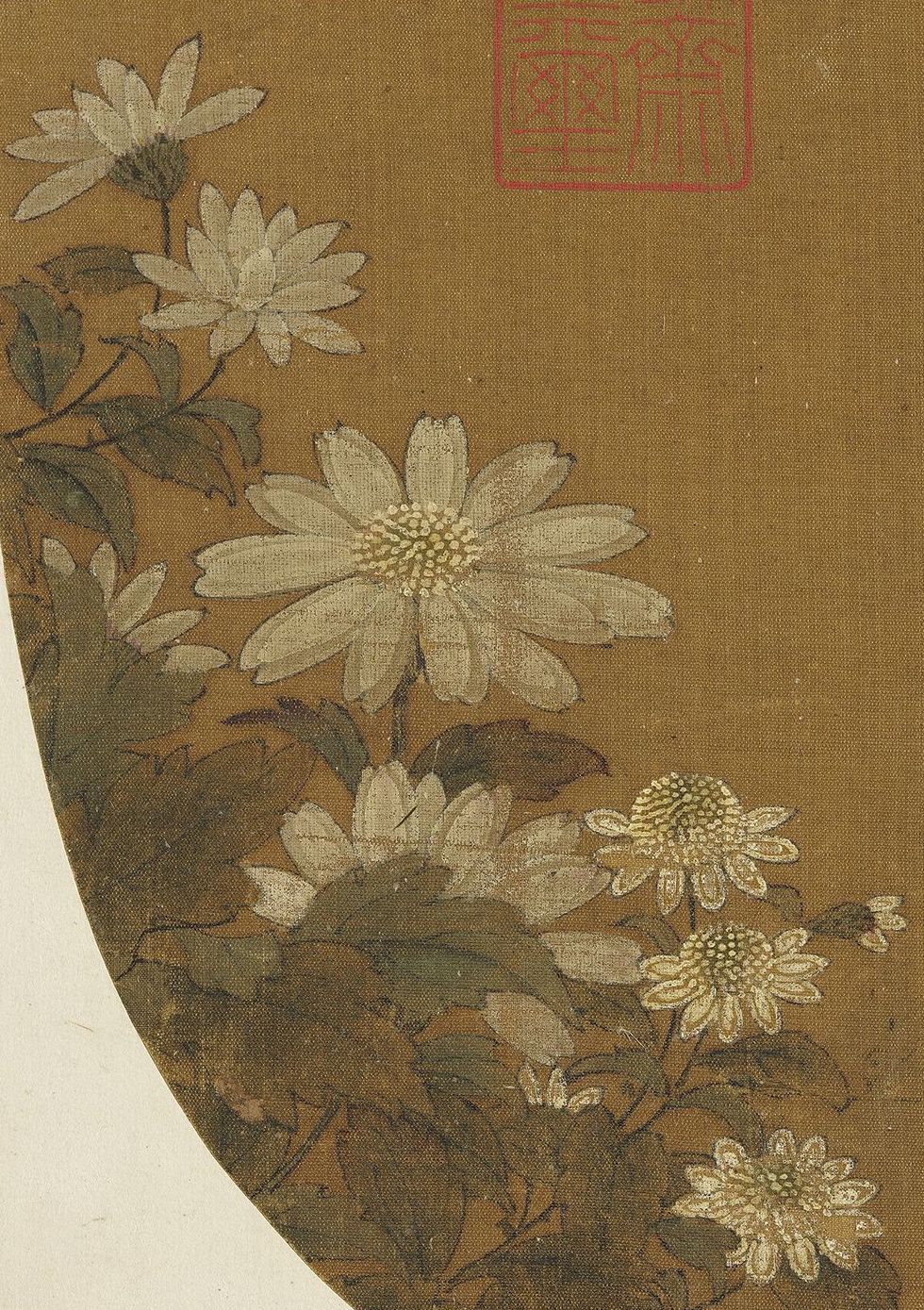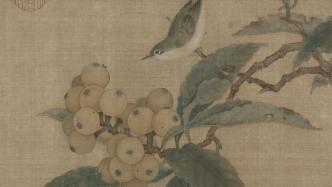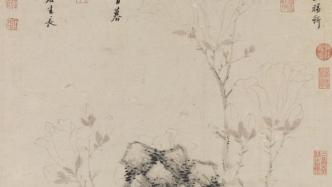
The thirteenth day of the ninth month of the lunar calendar is cold dew. During this season, people can clearly feel the change in temperature difference.
During the cold dew season, there is a custom in Jiangnan area to enjoy chrysanthemums while eating crabs. The so-called "holding claws to appreciate chrysanthemums" has left many poems and famous sayings by literati in all dynasties. In the seasons of Ming and Qing Dynasties, it has become a common practice to hold chelated chrysanthemums. For example, in the Qing Dynasty, Xin Hanqing said, "I prefer to plant new chrysanthemums this year, and discuss how to hold chelated chrysanthemums in autumn."
Among the famous works of calligraphy and painting in the past dynasties, there are portraits of crabs, such as the scene of opening their teeth and dancing claws on the remnant lotus, and there are also vivid works of double claws holding spikes. As for the depiction of chrysanthemums, there are even more to enumerate. There are not only exquisite sketches with exquisite workmanship, but also excellent freehand paintings with equal emphasis on calligraphy and painting. The former is like the page of "Autumn Flowers in Gallbladder Vase" by the Song Dynasty, and the autumn chrysanthemums are gorgeous and elegant; The latter has the scroll of "Ink Ju" by Shen Zhou of the Ming Dynasty, one Qiu Ju and one seven-character quatrain, each of which occupies half of the paper. In addition, Yuanren's "Laopu Qiurong" scroll, although not signed by the author, but the image in the painting is accurate, and the brush strokes are quick, which can be regarded as a masterpiece of freehand flower and bird painting.
The autumn wind rises, and the crab legs are fat. Chrysanthemums bloom, smell crabs. On the occasion of this late autumn festival, "The Paper, Ancient Art" specially combs the famous crab and chrysanthemum paintings in the Palace Museum and the Taipei Palace Museum for readers.

The Autumn Rong Scroll in the Yuanren Old Garden (part) Collection of the National Palace Museum, Taipei
The scorpion has always been rampant, and the rice is ripe and the autumn wind is full of spirit
Crabs can be said to be domineering in the lake, white meat and red paste in a bowl, unforgettable in autumn, and a poem on the tip of the tongue of writers. There are countless celebrities who like to eat crabs in all dynasties. Li Bai has a poem, "The crab claws are the liquid of gold, and the Qiuqiu is the Penglai". Su Shi also used poems for crabs and wrote the famous phrase "one poem for two tip groups". Song Xiaozong, who even ate delicacies from mountains and seas, suffered from dysentery because he liked crabs too much.
By the Ming and Qing Dynasties, people's love for crabs continued unabated. Li Yu expressed his love for crabs in "The Occasional Love": "Being alone in crabs, I can love it with my heart, and I can like it with my mouth, and I can't forget it no matter what it is for a lifetime." Even Li Yu's family joked He "takes the crab as his life, that is, he calls his money the money to buy his life." The money to buy the crab is Li Yu's life-continuing money.
Li Ruiqing, a great painter in the late Qing Dynasty and the early Republic of China, called himself the Taoist of Qing Dynasty and Taoist of Meihua An, but his name was too loud: "Li Baicra". It is said that he can eat 100 crabs in one meal, the amount of crabs is amazing.

Song Late Lotus Guo Suotu Page Collection of the Palace Museum
Among the masterpieces of calligraphy and painting in the past dynasties, there are portraits of crabs, such as the scene of opening their teeth and dancing claws on the remnant lotus, and there are also works of double claws holding spikes. For example, on the page of "Guo Suotu of Late Lotus" in Song Dynasty, a huge river crab squatted on the residual lotus with its teeth and claws, and its fat body crushed the lotus stem. The old lotus pods, withered lotus leaves, and sparse reeds add to the bleak and lonely atmosphere; the scroll of "Painting Guo Suotu" by Shenzhou in the Ming Dynasty has a crab with two claws holding ears, which is very divine; In Xu Wei's "Yellow Armor Picture" axis, the fat lotus leaf has begun to wither, and a crab is crawling slowly, leaving a large blank to express the autumn water. The composition is simple and clean, and the layout is fresh and ingenious.
In Song Dynasty, Shen Kai's "Old Crab with Jia Yun" records:
The yellow japonica rice is ripe and falls into the west wind, and the fertilizer enters the south of the Yangtze River in October.
Kneeling and staggering, the teeth are white, and the round umbilicus is red.
The old fragrant grinds pomelo in Guxuyuan, and the soup is smashed with finely chopped green onions.
Dispatch to Hengtang River to pick up passengers, hold the claws and don't let the wine glass empty.
Song He Crab Figure Page
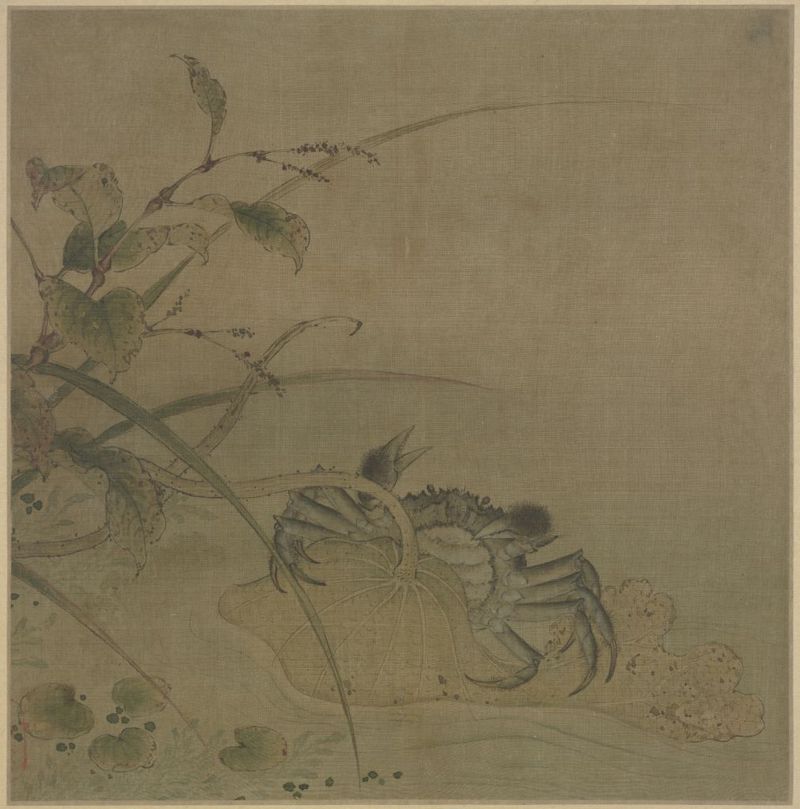
Song He Crab Map Page Collection of the Palace Museum
There is no item on this page. The seal is printed on one side, and the seal is blurred and indistinguishable.
In the picture, the ruined lotus leaf is withered and mottled, half immersed in water, and a female crab is lying on the leaf. Red polygonum, cattail grass, duckweed, algae, etc. grow and float in the gurgling water. The edges of the leaves have turned yellow, showing that it is approaching autumn, and the decline of lotus leaves forms a strong contrast with the freshness of female crabs. The picture is deliberately truthful, the lotus leaf is depicted with double hooks and leaves, the leaf tendons, stripes and small thorns on the scorpion are all deliberately crafted, and the female crab is meticulously and rigorously used. This picture is vivid in artistic conception and novel in subject matter, making it a model of realistic paintings by the Song Dynasty.
Song Wanhe Guo Suotu Page

Song Late Lotus Guo Suotu Page Collection of the Palace Museum
There is no item on this page. The seal "Jinling □□□□" in the collection of Qianjian.
In the picture, a huge river crab stands on top of the residual load with its teeth and claws, and its fat body actually crushes the lotus stem. The old lotus pods, withered lotus leaves, and sparse reeds add to the bleak and lonely atmosphere. The lotus leaves and lotus pods are outlined with a thick brush, and the crab is written with a fine brush. The brushwork is rough and realistic, and the coloring is strong. The old signature titled "Huang Jucai" is very far from Huang Jucai's painting style, so it is changed to Anonymous painting.
On the folio is a poem inscribed by Emperor Qianlong of the Qing Dynasty: "The scorpion has always been rampant, and the rice is ripe and the autumn wind is full of energy. Jiajie Xiang said that he is fearless, how to cook every meal." "Treasure of the Supreme Emperor" and other seals are printed in many places.
Once collected in the Qing Dynasty, it was recorded in "Shiqu Baoji Sequel".
Ming Shen Zhou painting Guo Suotu scroll
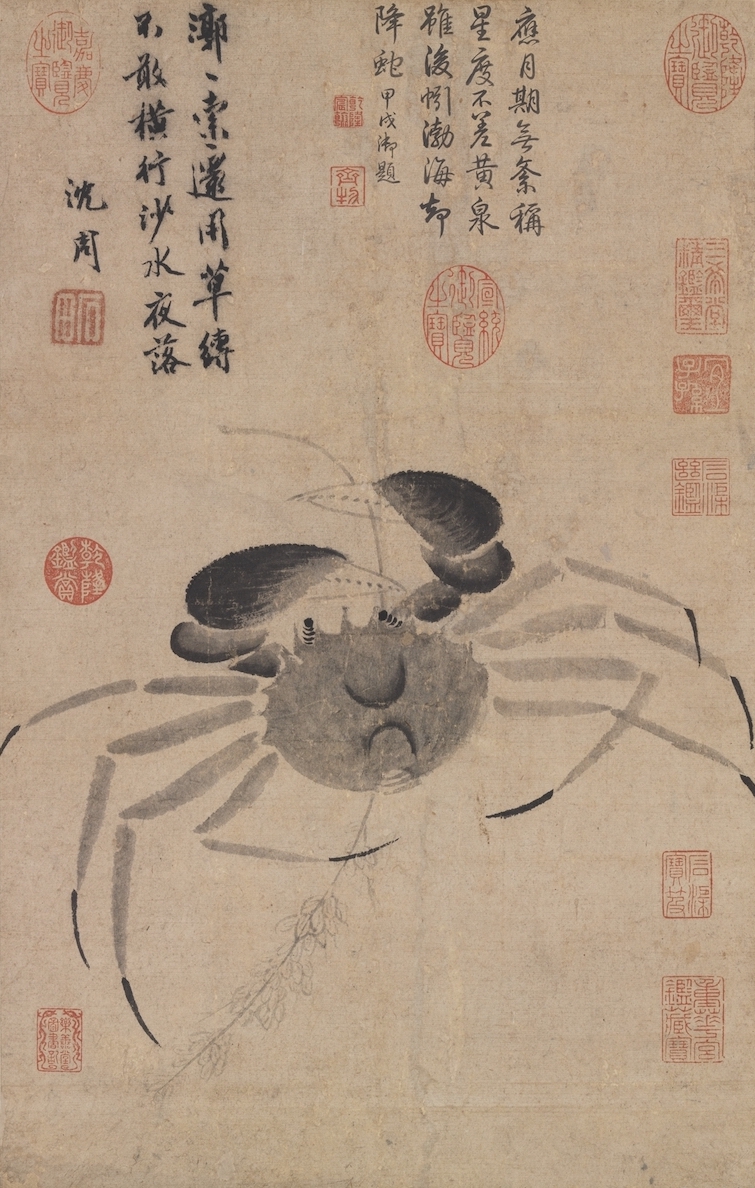
Ming, Shen and Zhou paintings, Guo Suotu scroll, in the collection of the National Palace Museum, Taipei
Shen Zhouxing wrote himself in regular script: He was swaying, and he was tied with grass. He didn't dare to run rampant, and the sand and water fell at night. Shen Zhou.
In this painting, there is a crab with two claws holding the ear, which is very magical, but the claws and feet have double strokes when they are written, not like a sketchbook. The style of writing style, around the age of eighty, cannot be determined when it was created.
Ming Shenzhou Sketchbook Crab and Shrimp
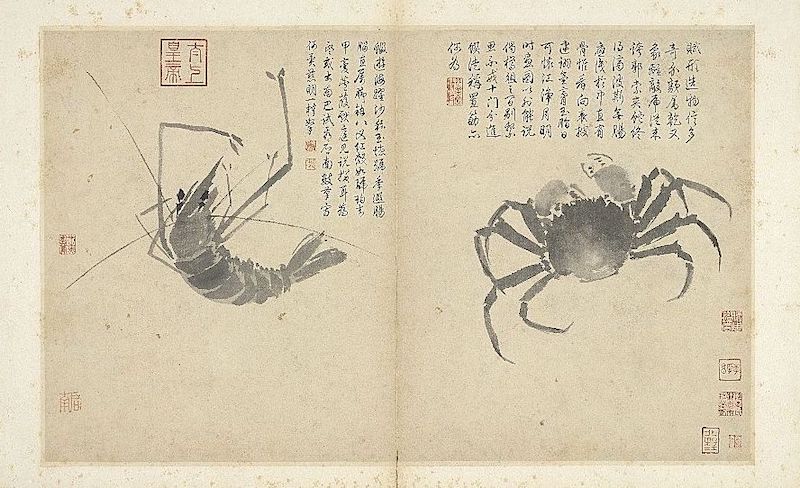
Ming Shen Zhou Sketchbook Crab and Shrimp Collection of the National Palace Museum, Taipei
This piece has the imperial inscription in the running script of Emperor Gaozong of the Qing Dynasty: Formation and Creation of Xinduoqi, which belong to the category of Gan and Xiangli. The enemy tiger has always praised Guo Suo, and the snake has finally won Jibos. The gutless should be aware of the middle and straight, and the boneless one should look towards the surface. On the day of catching the golden paste and jade fat, it is the time when the moon is bright on the river. Apart from drawing pictures, you can speak verses, but don’t think about it. If you don't give up the ten points to enter the food, what is the only way to call it home.
Ming Xu Wei yellow armor map

Ming Xu Wei and Yellow Armor Scroll Collection of the Palace Museum
This piece is signed "Tianchi". The seal "Xu Wei's private seal" and other two seals. The fat lotus leaf in the picture has begun to wither, and a crab is crawling slowly, leaving a large blank to express the autumn water. The composition is simple and clean, and the layout is fresh and ingenious.
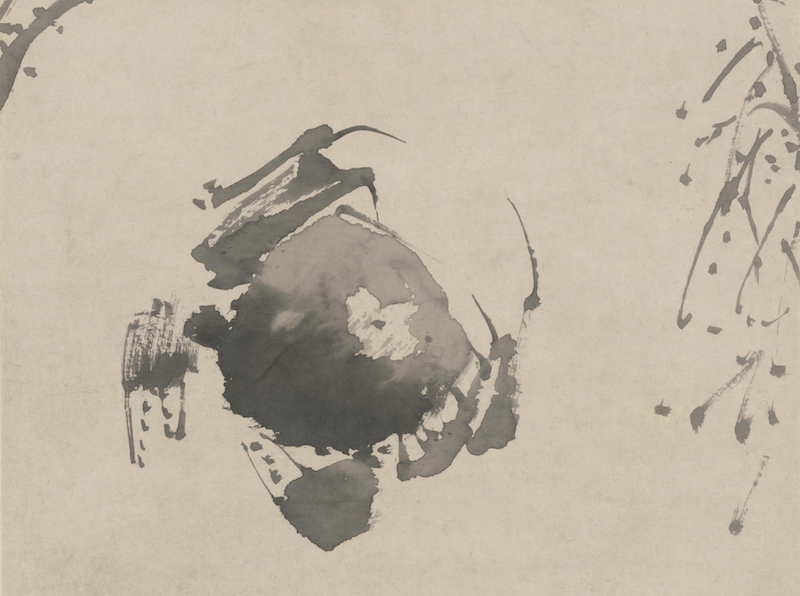
Ming Xuwei Yellow Armor Scroll (Part) Collection of the Palace Museum
The ink in the picture is added with an appropriate amount of glue to prevent the ink from oozing out, which is the characteristic of this picture. In the picture, the lotus leaf is painted with dripping ink, and the crab is painted with a few strokes. It seems to be done in haste, but in fact, a variety of strokes are used: thick, light, dry, wet, hook, smear, and dot. Although the shape is exaggerated, it is rich. Ink fun. A poem inscribed on the painting says: "There is something arrogant and rude, don't ask if you have pearls in the past years. You don't know if you have been raised orphaned, and when you come to Huangjia, you will be alone." Poetic and humorous.
Qing Zhangpan double crab picture fan page
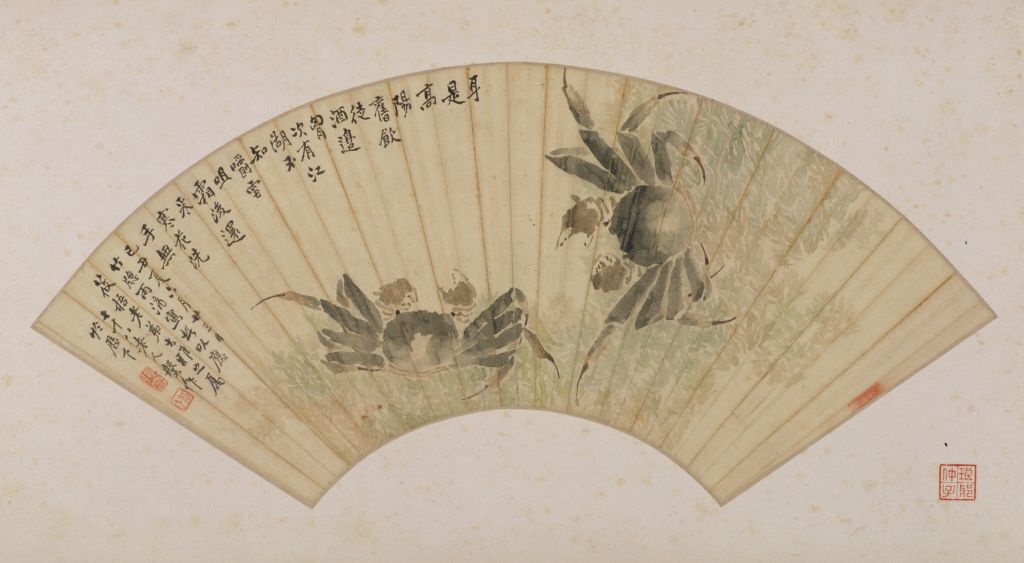
Qing Dynasty Zhang Pan's Two Crabs Fan Page Collection of the Palace Museum
This piece of self-knowledge: "Ear is an old drinker in Gaoyang, and there are rivers and lakes around the wine. I don't know that after chewing snow and frost, I also pick cold flowers to wash my hands. I wrote on the bamboo window on June 23, raindrops, in response to this. The genus of Wuwu's younger brother Taiya. The seventy-eight old man's penance is written under the calendar." The seal "Zhang Sou" is printed in white. "Ji Chou" was in the fifteenth year of Emperor Guangxu's reign (1889), and the author was 78 years old.
This fan depicts two crabs climbing on the grass, which is vivid and full of life. Crabs are drawn using the boneless method, with elegant colors and simple strokes. The inscriptions are dense and dense, and the content and the theme of the painting echo each other, showing the leisurely mood of literati and elegant scholars. It is a very interesting sketch of Zhang Pan in his later years.
Qing Renyi Pineapple Chrysanthemum Crab Page

Qing Renyi Pineapple Chrysanthemum Crab Page Collection of the Palace Museum
This picture is signed: "Written in Ruilian Jingshe in Ruilian Jingshe, Xugu." Inscription "Xugu Calligraphy and Painting", "Thirty-Seven Peaks Thatched Cottage" Zhu Wenyin two sides. "Renwu" was the eighth year of Guangxu in the Qing Dynasty (1882), when Xugu was 60 years old.
Ren Yi (1840-1896), originally named Run, styled Xiaolou and Bonian, was a native of Shaoxing, Zhejiang Province. He lived in Shanghai and made a living by selling paintings. Good at figure, portrait, flower and bird, landscape painting. In addition to inheriting folk and traditional literati paintings, his paintings incorporate the strengths of Chen Hongshou, Chen Chun, and Xu Wei, as well as absorb Western sketching and coloring techniques, forming a colorful, novel and vivid unique style of art, with artistic interest that both elegant and popular can appreciate. and a distinct atmosphere of the times. Together with Ren Xiong, Ren Xun, and Ren Zhu, they are called "Four Rens at Sea".
It is written that there is only one plant in Dongliqiu, and the cold and fragrant evening is as pale as nothing.
Every season has a flower that suits its ethos. The ninth month of the lunar calendar when the cold dew arrives, also known as the chrysanthemum month, is the month of chrysanthemums. Unlike most flowers that bloom in spring and summer, chrysanthemums are anti-seasonal flowers. The "Chrysanthemum Beginning Yellow Flower" in the "Three Hours of Cold Dew" refers to the general blooming of chrysanthemums at this time.

Song Linchun, Autumn Chrysanthemum, Cong Chrysanthemum (Part)
According to classic records, the history of chrysanthemum cultivation in China has been more than 3,000 years. The earliest records can be found in "Zhou Guan" and "Bu Ya". "Book of Rites Yueling Chapter": "In the autumn of the season, Ju has yellow flowers", indicating that chrysanthemums bloomed in the autumn moon, and they were all wild species at that time, and the flowers were yellow. From the Zhou Dynasty to the Spring and Autumn Period and the Warring States Period, there are records of chrysanthemums in the "Book of Songs" and Qu Yuan's "Li Sao". "Li Sao" has the phrase "drinking the dew of magnolia in the morning, and eating the fall of autumn chrysanthemum in the evening".
"Shen Nong's Materia Medica" recorded in the Han Dynasty: "Chrysanthemum for a long time can lighten the body and prolong life". "Xijing Miscellaneous Notes": "When the chrysanthemum is blooming, the stems and leaves are collected, and the mixed millet is brewed. When it is ripe on September 9 of the next year, it is drunk, so it is called chrysanthemum wine." From these records, chrysanthemum was cultivated in China for food and medicinal purposes at first.

(Biography) Scroll of Ming and Tang Dynasties Picking Chrysanthemums (Part) Collection of the National Palace Museum, Taipei
Tao Yuanming (355-417) of the Jin Dynasty loved chrysanthemums, which was widely circulated. He has written many poems on chrysanthemums, such as "picking chrysanthemums under the eastern fence, leisurely seeing the southern mountains"; "autumn chrysanthemums are beautiful, and they are even more exposed" and other famous lines, which are still popular today. At that time, the scholar-officials admired their high-spirited festivals and admired many kinds of chrysanthemums.
Since the Tang Dynasty (618-907), the cultivation of chrysanthemum has become more and more common, and the cultivation technology has been further improved. For example, Li Shangyin's poem: "Darkly and faintly purple, melding and melding yellow". Bai Juyi's poem: "The garden is full of chrysanthemums and tulips, and there are solitary bushes that look like frost" and so on. In the Song Dynasty "Hangzhou Fuzhi", it was recorded: "There is a flower market in Lin'an, and chrysanthemums are made into flower towers". It can be seen that Lin'an, the capital of the Southern Song Dynasty, had a flower market and flower fair. The chrysanthemum festival that has been passed down to this day started in Hangzhou during the Southern Song Dynasty. In the Qing Dynasty, the varieties of chrysanthemums and monographs were increasing day by day. During the Qianlong period, there were people who presented various kinds of chrysanthemums to the Qing emperor.
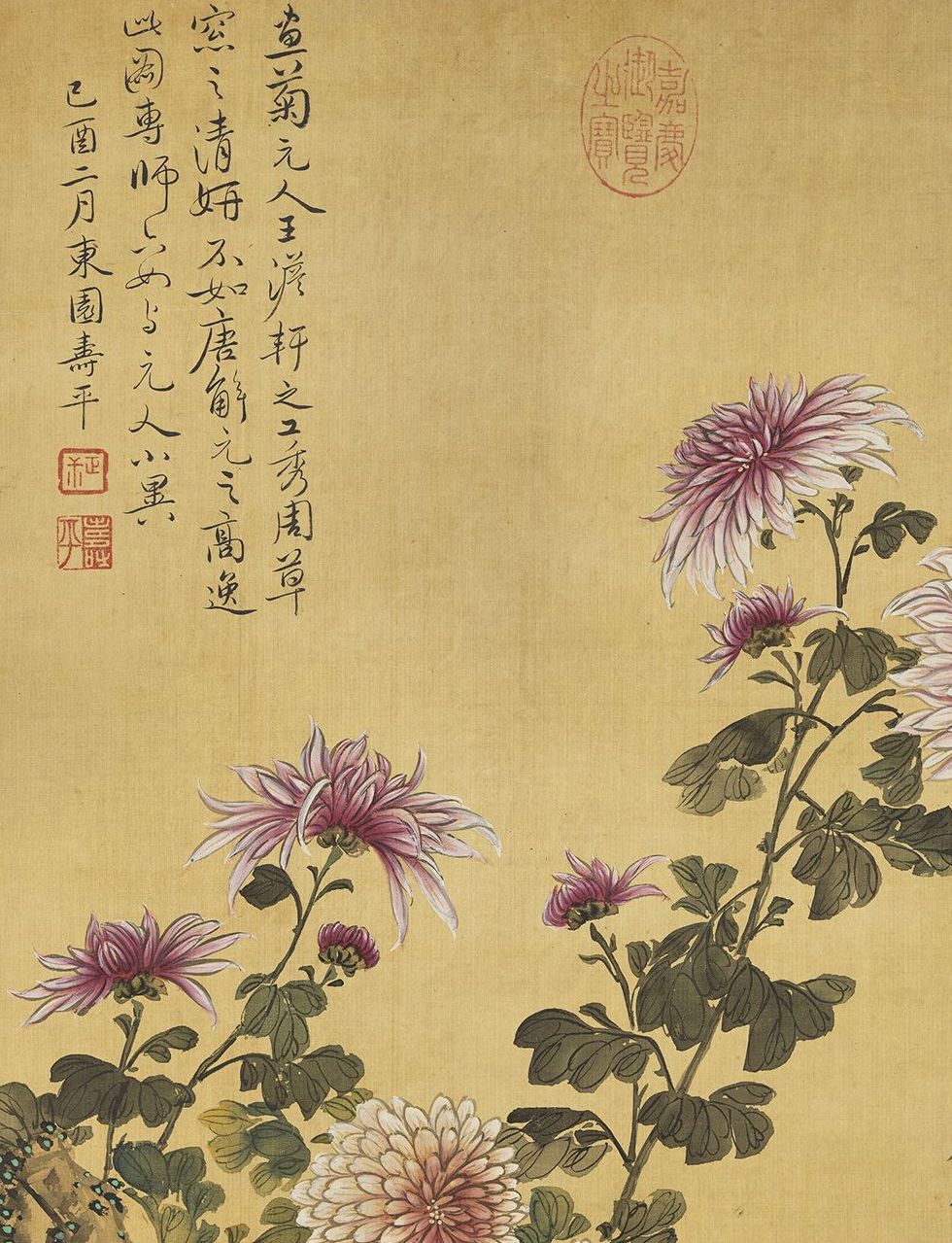
A chrysanthemum scroll by Shouping of Qing Dynasty (detail) Collection of the National Palace Museum, Taipei
Among the famous works of calligraphy and painting in the past dynasties, the description of chrysanthemum is even more numerous. There are not only exquisite sketches with exquisite workmanship, but also freehand masterpieces with equal emphasis on calligraphy and painting. The red and elegant, clustered on the green branches, are gorgeous without losing elegance; the composition of the page of Song Zhu Shaozong's "Chrysanthemum Cong and Flying Butterfly" is complicated and splendid like a brocade. The latter has the scroll of "Ink Ju" by Shen Zhou of the Ming Dynasty, one Qiu Ju and one seven-character quatrain, each of which occupies half of the paper. In addition, Yuanren's "Laopu Qiurong" scroll, although there is no author's signature, but the image in the painting is accurate, and the brush strokes are quick, which can be regarded as a masterpiece of freehand flower and bird painting.
Song Autumn Flowers in Gallbladder Vase
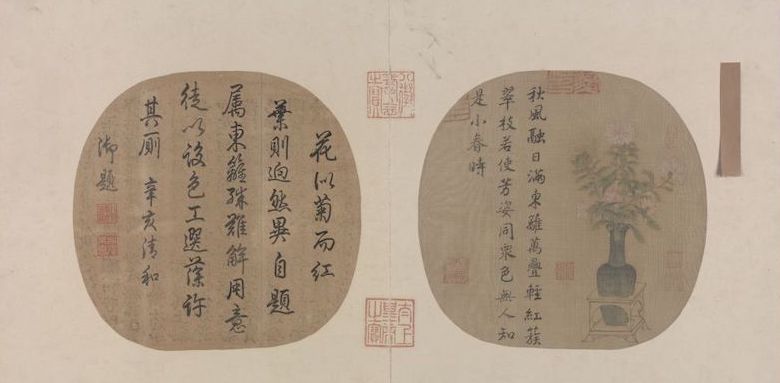
Song Dynasty Gallbladder Vase with Autumn Flowers in the Collection of the Palace Museum
There is no item on this page. There are six seals in the collection: "Jiaocuixuan Seal", "Shenpin", "Zijingfu Seal", "Xiang Yuanbian Seal", "Xiang Molin Appreciation Seal" and "Zhang Zezhi".
In the picture, a blue-glazed long-necked vase with chrysanthemums is placed on the bottle rack. The flowers are painted with outline and color, and the flowers and leaves are drawn with the boneless method. The depiction is natural and delicate, and the rendering is soft and moist. Qiu Ju is gorgeous without losing its elegance. This picture is an excellent work in the Southern Song Dynasty sketch painting.
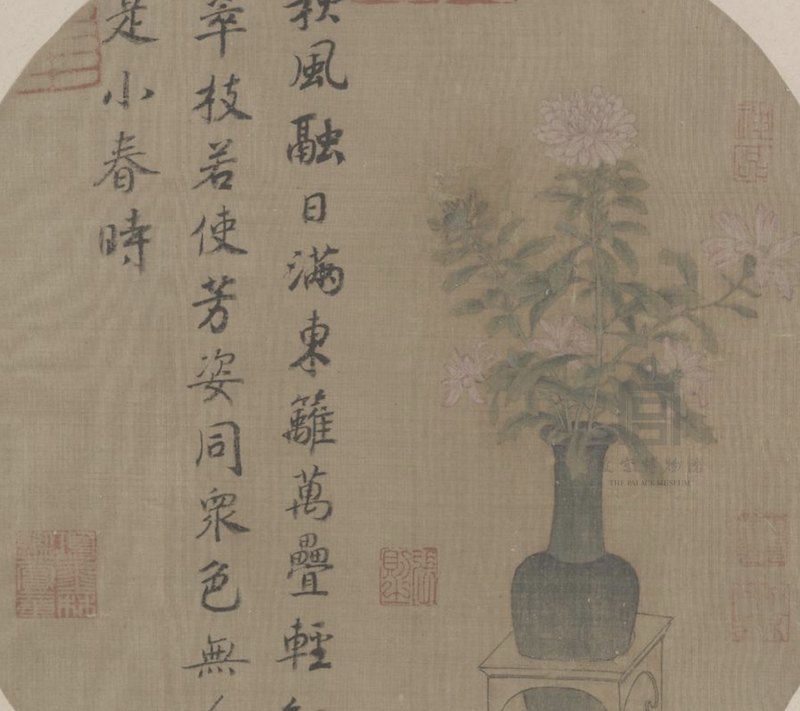
Song Dynasty, Autumn Flowers in Gallbladder Vase (detail) Collection of the Palace Museum
The poem on the left side of the painting page reads: "The autumn wind is melting and the sun is full of the eastern hedge, ten thousand stacks of light red clusters of green branches. If the fragrance is the same as the color, no one knows it is the time of Xiaochun." This is a scene poem, describing the light red flowers in the vase Elegant, clustered in green branches.
On the opposite panel is a poem inscribed by Emperor Qianlong of the Qing Dynasty: "The flowers are like chrysanthemums and red, but the leaves are quite different. The inscription belongs to the winter hedge, and it is difficult to understand the meaning. I only use the color work, select the algae to allow its toilet. Xinhai Qinghe Imperial Inscription ."銤 "The treasure of the eight expeditions", "the treasure of self-improvement" and "the treasure of the emperor".
Qing "Shiqu Baoji" description.
Song Cong chrysanthemum map page

Song Cong chrysanthemum map page Collection of the Palace Museum
There is no item on this page. Collected seals "□Tengxianguan painting and calligraphy", "Cloud Valley", "□Huabaoyou", and another seal is incomplete.
The picture is a clump of autumn chrysanthemums, red and white, with luxuriant branches and leaves, full of vitality, and there is no chilling autumn. The petals are outlined with a fine center pen, and then smudged with vermilion or white powder; the stamens are pointed out with a fine pen; the dense leaves are dyed with ocher, slightly juicy green, or slightly garcinia to show the different colors of age and tenderness . The flowers are about to bloom, bloom, and will end, the leaves are rolled up and the light and shade are turned to the back, all of which are portrayed just right. The style of painting is delicate, the composition is plump, complicated but not chaotic, dense but not suffocating, and the coloring is bright but not vulgar. It is a masterpiece of sketch painting in the Southern Song Dynasty.
Song Zhu Shaozong's chrysanthemum and flying butterflies
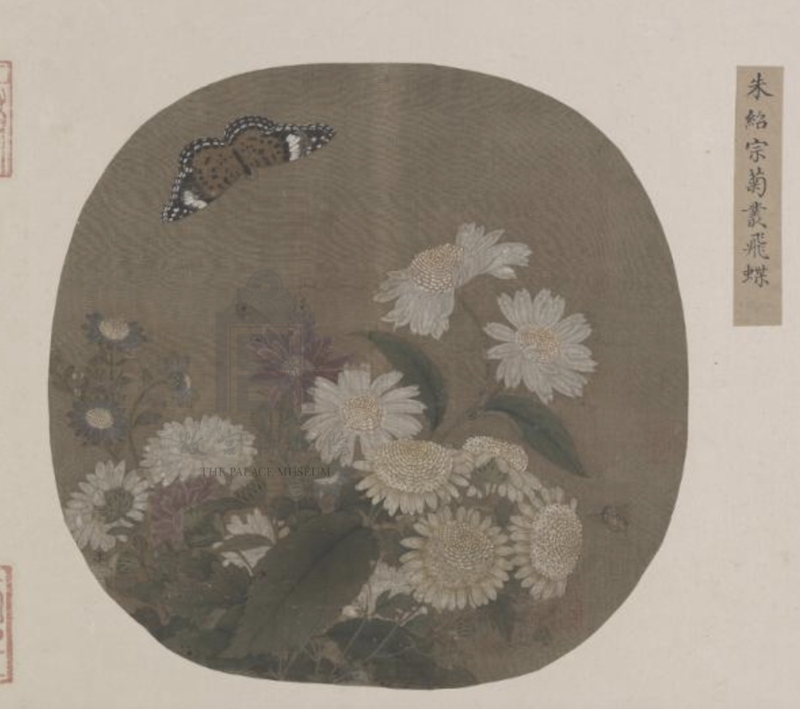
Song Zhu Shaozong Chrysanthemum and Butterfly Drawing Page Collection of the Palace Museum
The inscription on this inscription: "Zhu". There are 2 seals in the collection of Qianjian, and the seals are vague, only the word "Lin" can be discerned. Mounted side inscription: "Zhu Shaozong chrysanthemum flying butterflies".
Drawing chrysanthemum blooming. The flowers are divided into four colors: yellow, white, blue and purple, and the composition is complicated and brilliant. Although it is a wild scenery, it is rich and elegant. Bees follow the flowers, and nymphs fly up and down, adding a sense of dynamism to the picture. The dyeing of petals and leaves is very refined, and the center of the flower is dyed with white powder, which has a strong three-dimensional effect and seems to protrude above the silk. The history of painting says that the author "depicts and dyes exquisitely, far beyond the peers", and the letter is true.
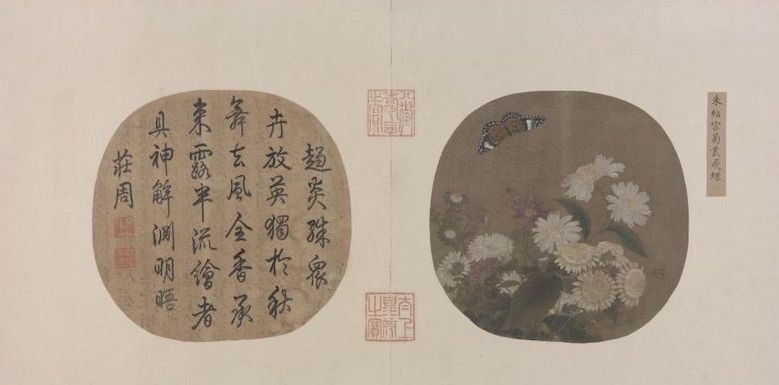
Zhu Shaozong Chrysanthemum and Butterfly Map Page Collection of the Palace Museum
There is a poem inscribed by the Emperor Qianlong of the Qing Dynasty on the opposite page: "There are many flowers in the flames, and the British are unique in the autumn. The dance is full of fragrance and the fragrance is full of fragrance. The Treasure of Conquering Nian's "Zhu Wenyin" and "Self-improvement" Bai Wenyin.
Saved in the book "Selected Algae from the Four Dynasties". "Shiqu Baoji Sequel" description.
Song Linchun Qiuqing Cong Chrysanthemum
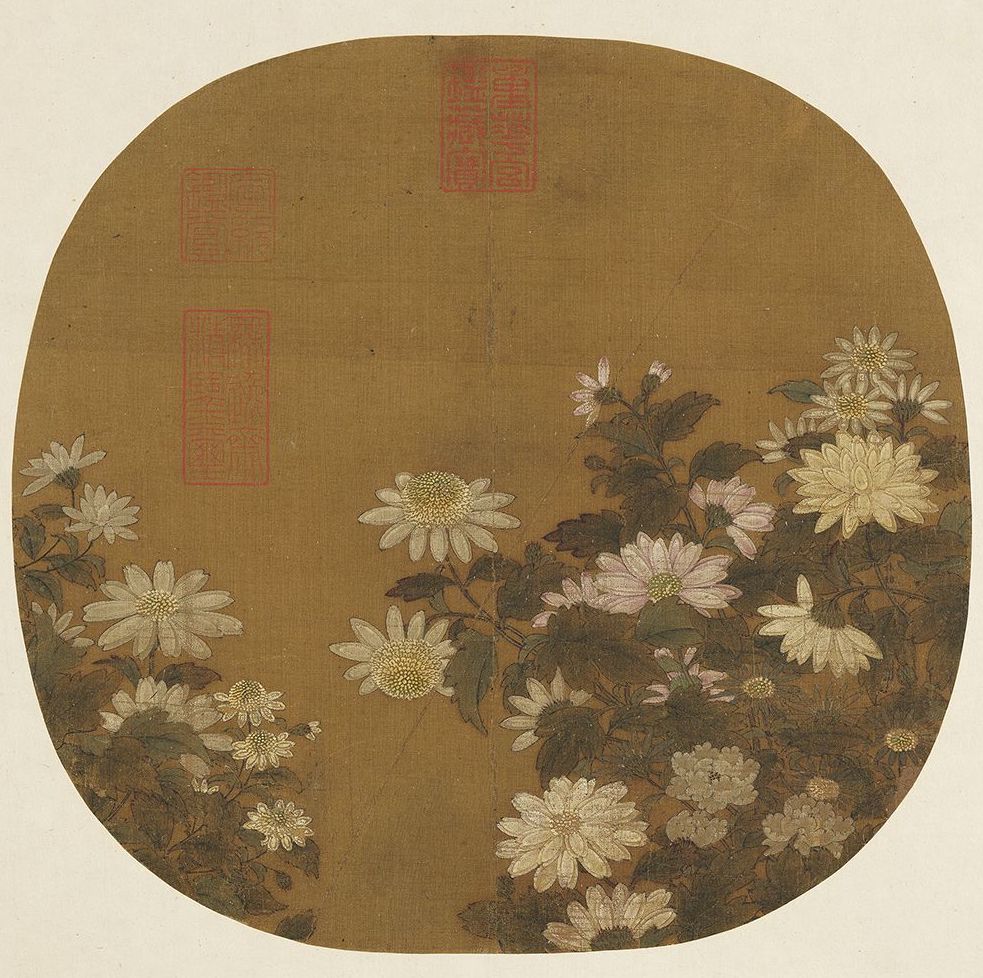
Song Linchun, Qiuqing, Congju
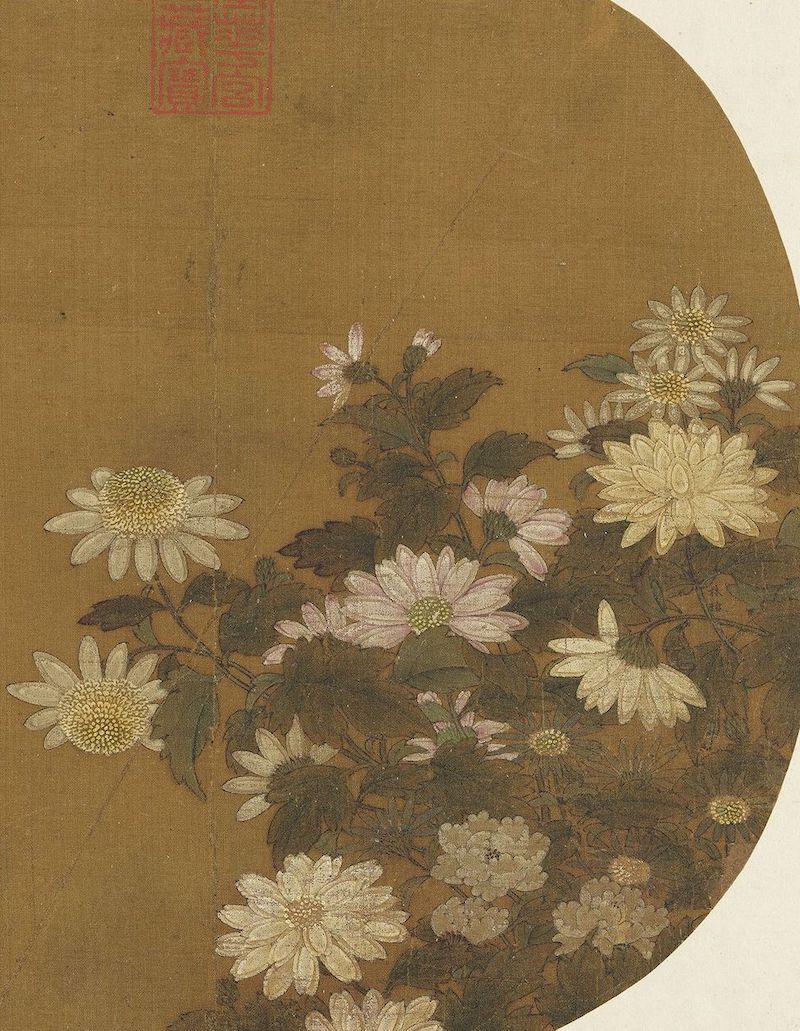
Song Linchun, Autumn Chrysanthemum, Cong Chrysanthemum (Part)

Song Linchun, Qiuqing, Congju
This painting has a royal inscription in the running script of Emperor Gaozong of the Qing Dynasty: Flowers, love, and leaves are always clear, and they are only good at names. Covering the bottom must be five willows, whose people cannot see Ding Yuanming. Qianlong Xinhai (1791) early autumn imperial inscription.
Yuanren Old Garden Autumn Rong Axis

Yuanren Old Nursery Autumn Rong Scroll Collection of the Palace Museum, Taipei
Next to the strange stone, two chrysanthemums of different varieties are competing to bloom beautiful flowers. The two bees were attracted by the fragrant aroma and hovered in the air, unable to bear to leave for a long time. Between the cracks, there are four sparrows dancing and foraging. The quiet ink color at the bottom of the picture, and the beautiful coloring in the upper section, not only form a strong contrast, but also add to the feeling of refreshing autumn weather.
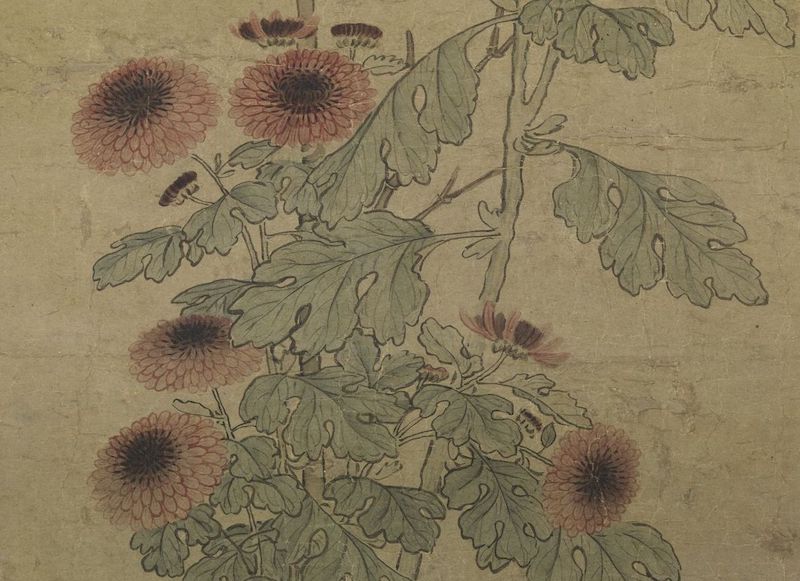
The Autumn Rong Scroll in the Yuanren Old Garden (part) Collection of the National Palace Museum, Taipei
Although this painting does not have the author's signature, it is impossible to know who painted it, but the image in the painting is accurate and the brush strokes are quick. It is indeed a masterpiece of freehand flower and bird painting.
Yuan Ren Cong Chrysanthemum Chart Axis

Yuanren Cong Chrysanthemum Scroll Collection of the Palace Museum, Taipei
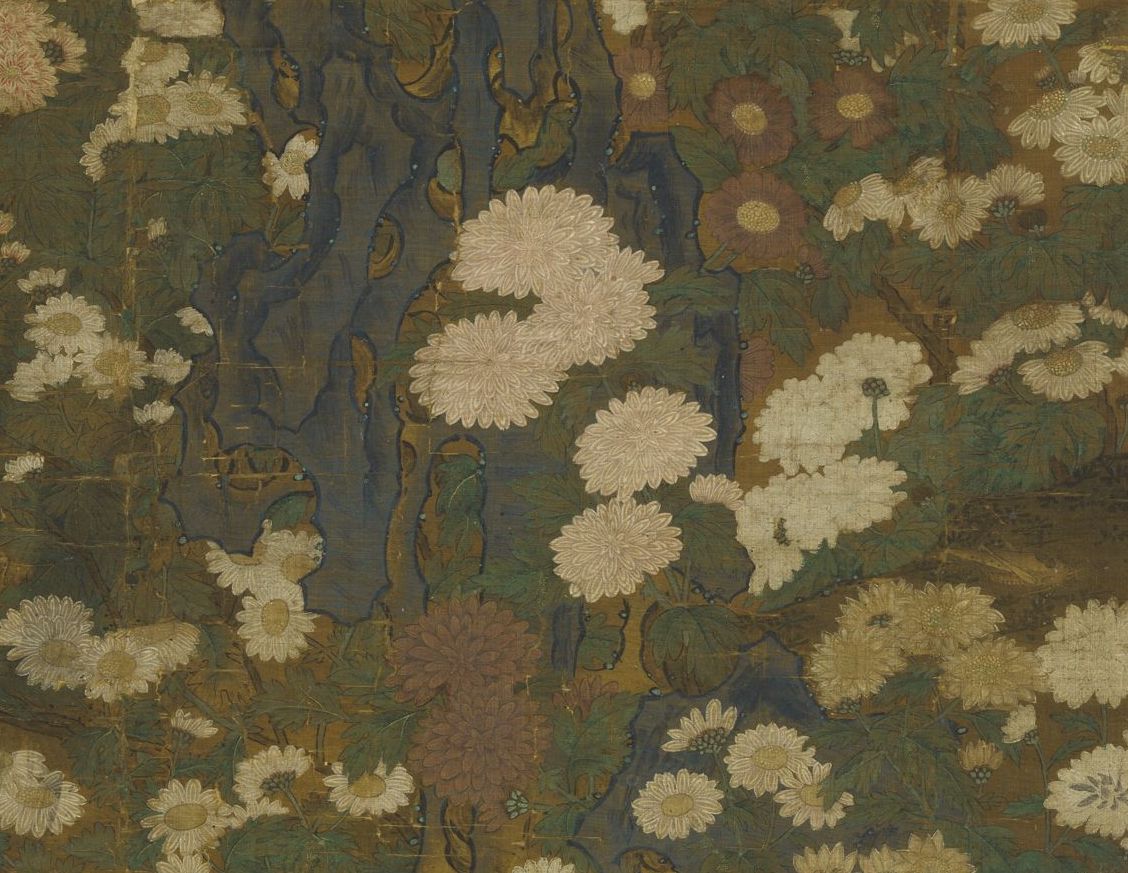
Yuan Ren Cong Chrysanthemum Scroll (Part) Collection of the National Palace Museum, Taipei
Ming Lu Ji double dove map axis

Ming Lu Ji double dove drawing scroll in the collection of the National Palace Museum, Taipei
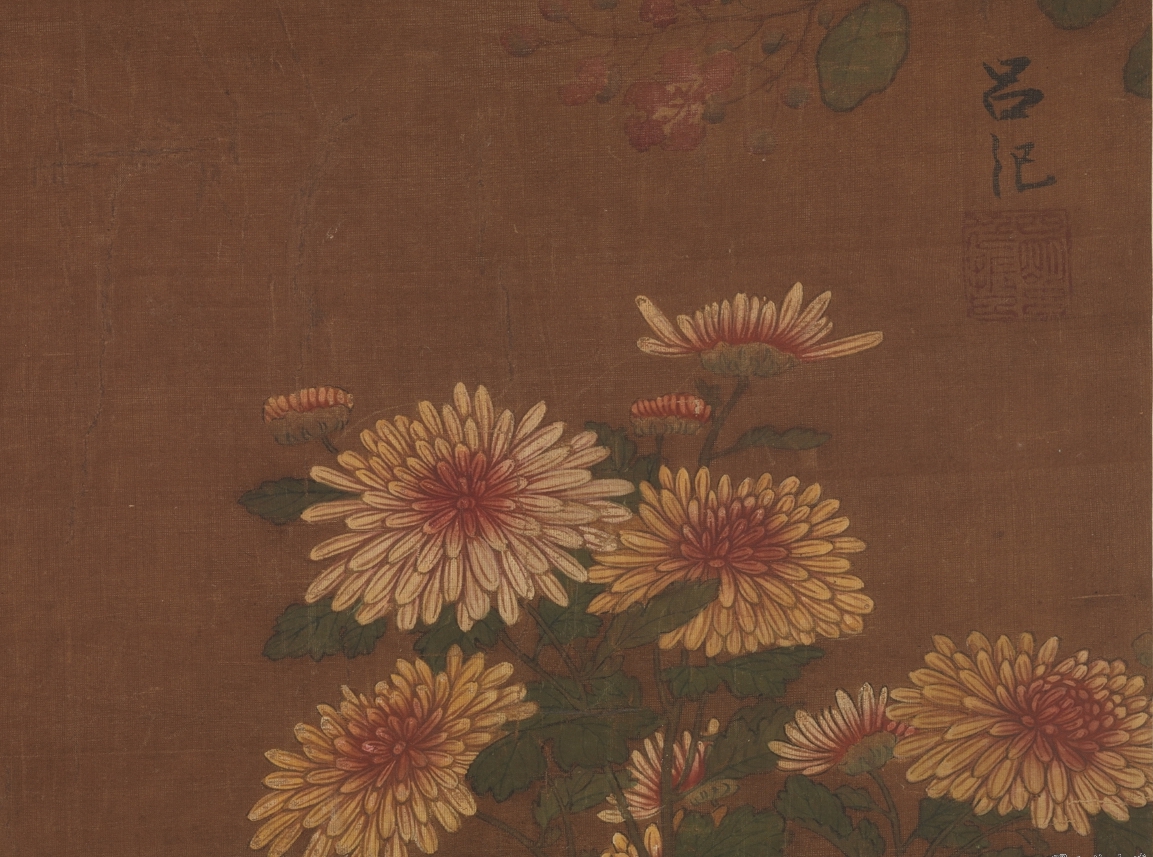
A Scroll of Double Doves in Lu Ji of Ming Dynasty (detail) Collection of the National Palace Museum, Taipei
Ming, Shen and Zhou ink chrysanthemum scroll

Ming, Shen and Zhou ink chrysanthemum scrolls in the collection of the National Palace Museum, Taipei
There is a branch of autumn chrysanthemum, the pavilion is independent, and the above title is a seven-character quatrain. The words and paintings each occupy half of the paper, leaving a slight gap in the middle. Before the Song Dynasty, there was absolutely no inscription outside the name of the painting, and most of them were not signed. The Northern Song Dynasty Emperor Huizong had his own painting. In the Southern Song Dynasty, Ma Hezhi, Ma Yuan, Ma Lin's works, Song Ningzong and Empress Yang mostly wrote poems on the paintings. After Qian Xuan and Zhao Mengfu, there were more and more self-inscribed works, but all of them did not hide the words. Shen Zhou paid equal attention to the status of several books and paintings, and Tang Yin and Wen Zhengming also had the same status. The painting has no year mark, and it is suspected that the sketchbook and the sketchbook were made at the same time and one after the other. Hongzhi Jiayin (1494) was sixty-eight years old.
Shen Zhou (1427-1509), a native of Changzhou, Jiangsu, with the word Qinan and the number Shitian, is also known as Baishiweng. Landscape, flowers, poultry and fish are all divine products, and he is one of the four masters of Ming Dynasty.
Ming Shen Zhou sketchbook chrysanthemum
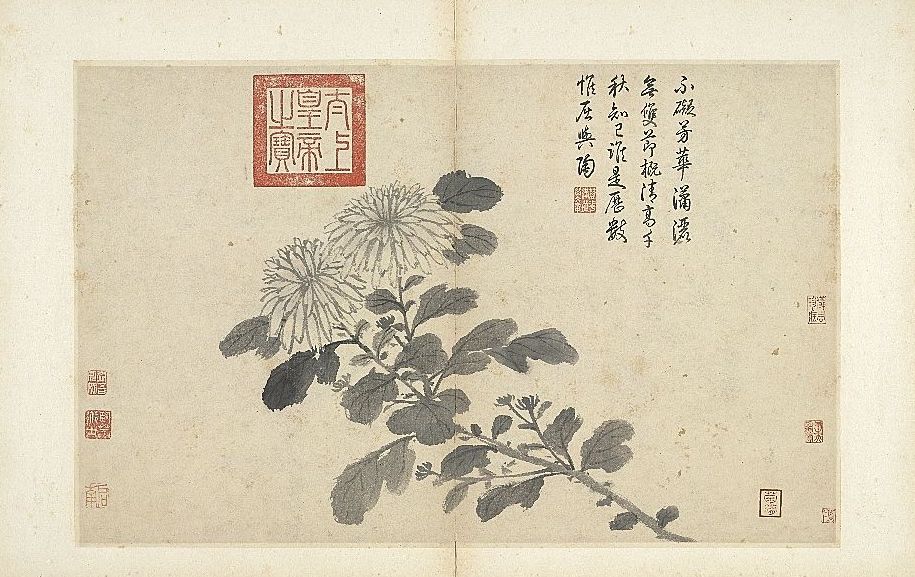
Ming Shen Zhou sketchbook chrysanthemum Collection of the National Palace Museum, Taipei
This painting, reclining chrysanthemums, is the eighth opening of Shen Zhou's "Sketch Book". The rough brushwork is light and calm, and it is swiped in haste.
Ming Shen Zhou bottle chrysanthemum
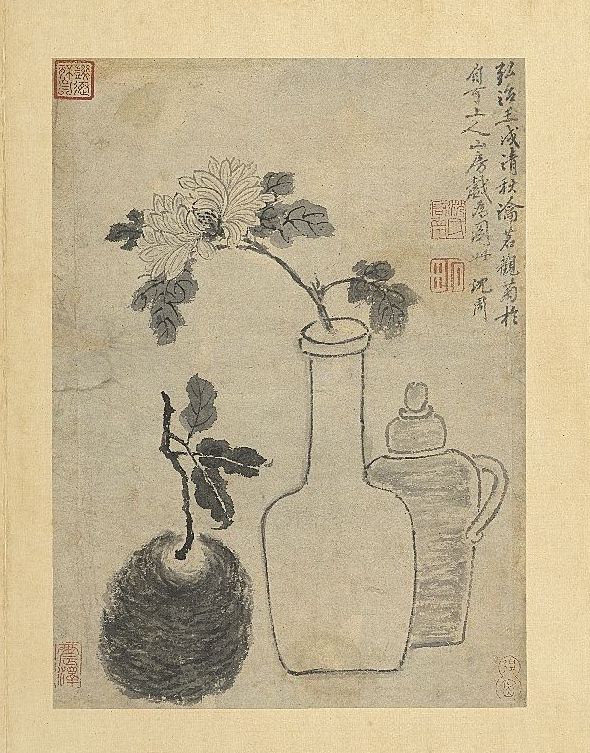
Ming Shen Zhou Ping Ju This painting is selected from the Collection of Ancient Pictures and Paintings in the National Palace Museum, Taipei
This painting has a self-inscription in the running script of Shen Zhou: Hongzhi Renxu (1502) Qingqiu, Qingming Guanju in Zike Shangren Shanfang, the play is shown here. Shen Zhou.
(Biography) Ming Tang Yin Picking Chrysanthemum Chart Axis
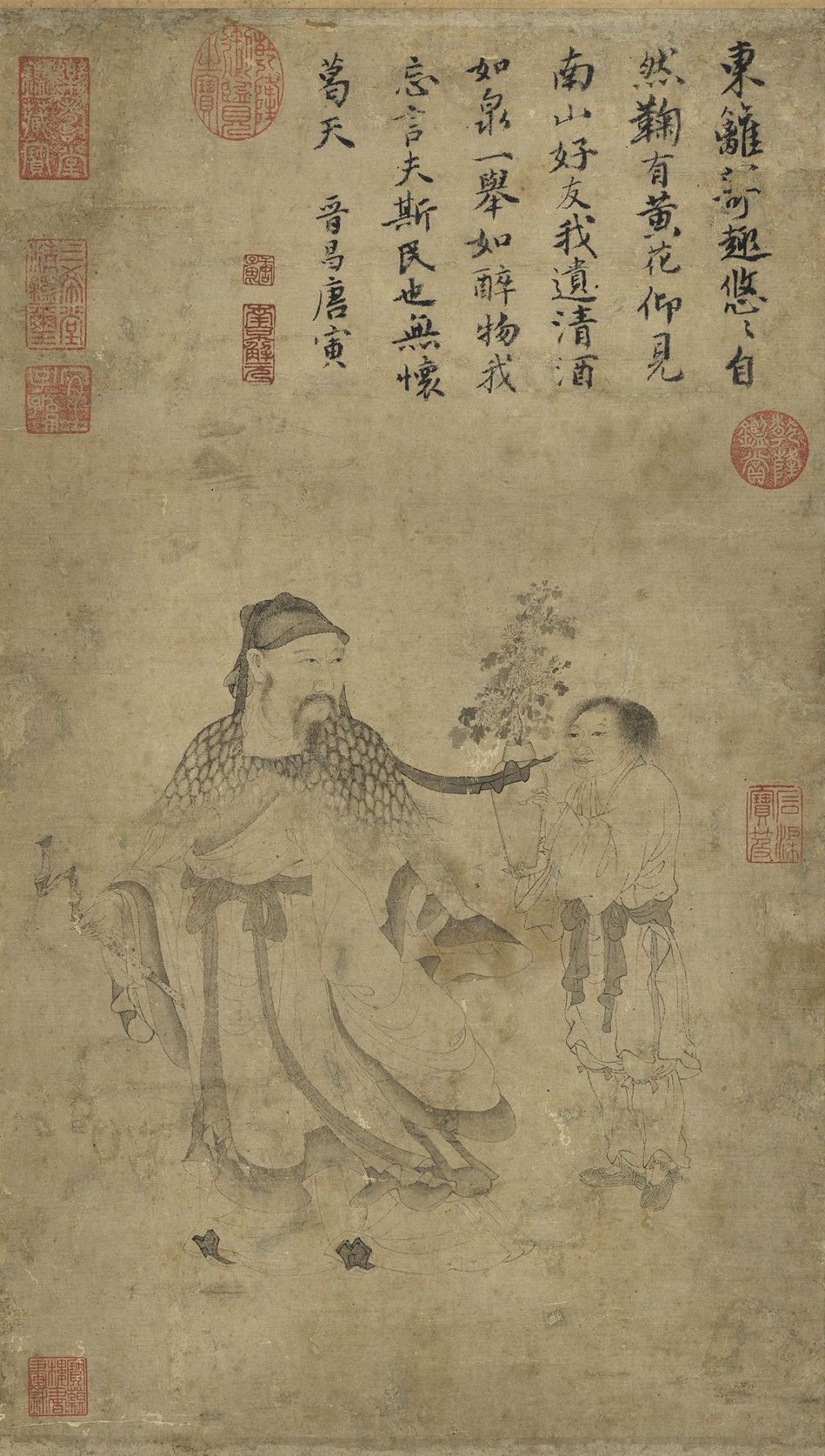
(Biography) Ming Tang Yin Picking Chrysanthemum Scroll Collection of the National Palace Museum, Taipei
In this painting, Tao Yuanming walks with a cane, a servant holds a vase of chrysanthemum in his hand. Tao Yuanming loved chrysanthemums, and there were many famous chrysanthemums in his life, such as "picking chrysanthemums under the eastern hedge, leisurely seeing Nanshan", "autumn chrysanthemums are beautiful", etc. Therefore, Tao Yuanming's portraits are often accompanied by chrysanthemums. And chrysanthemum's Xiufang, along with Tao Yuanming's clear personality, became a symbol of a gentleman. Although this work has the name of Tang Yin, but the pattern of the clothes is weak and weak, it should be a fake work for future generations.
Tang Yin (1470-1523) was a native of Wu County (Wu County, Jiangsu). The character is Ziwei, and the character is Bohu, and the number is Liuru. One of the Four Great Masters of Ming Dynasty.
Mingxiang Shengmo chrysanthemum bamboo and stone axis
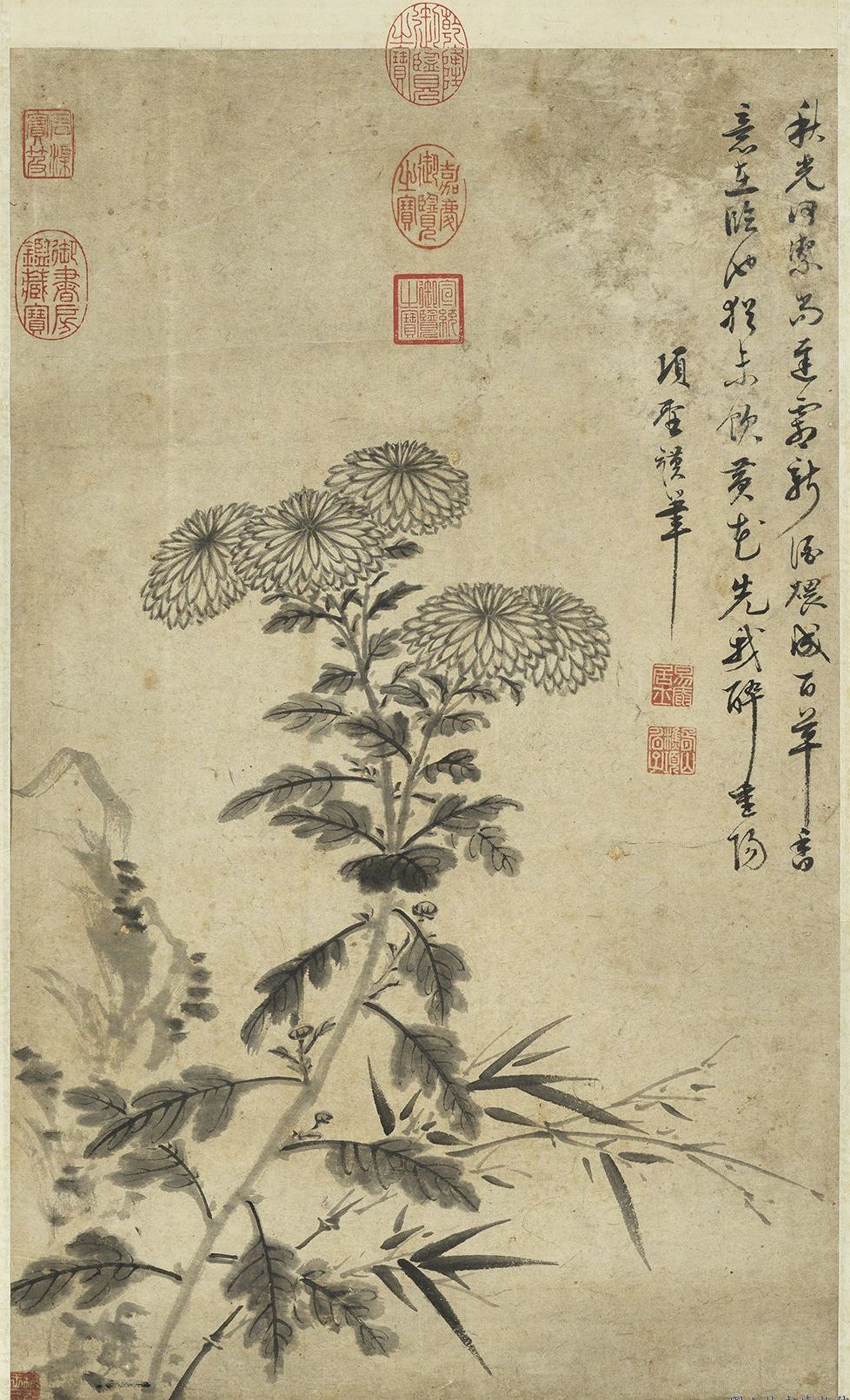
Mingxiang Shengmo Chrysanthemum Bamboo Stone Scroll Collection of the National Palace Museum, Taipei
This piece is titled in cursive script by Youxiang Shengmo: Qiuguang He Jie is still frost, and the new wine is simmered into a hundred herbs. The meaning is that I have not drunk before the pond, and I am drunk on Chongyang before the yellow flowers. Xiang Shengmo pen.
Ming Chen Chun painted chrysanthemums into a fan
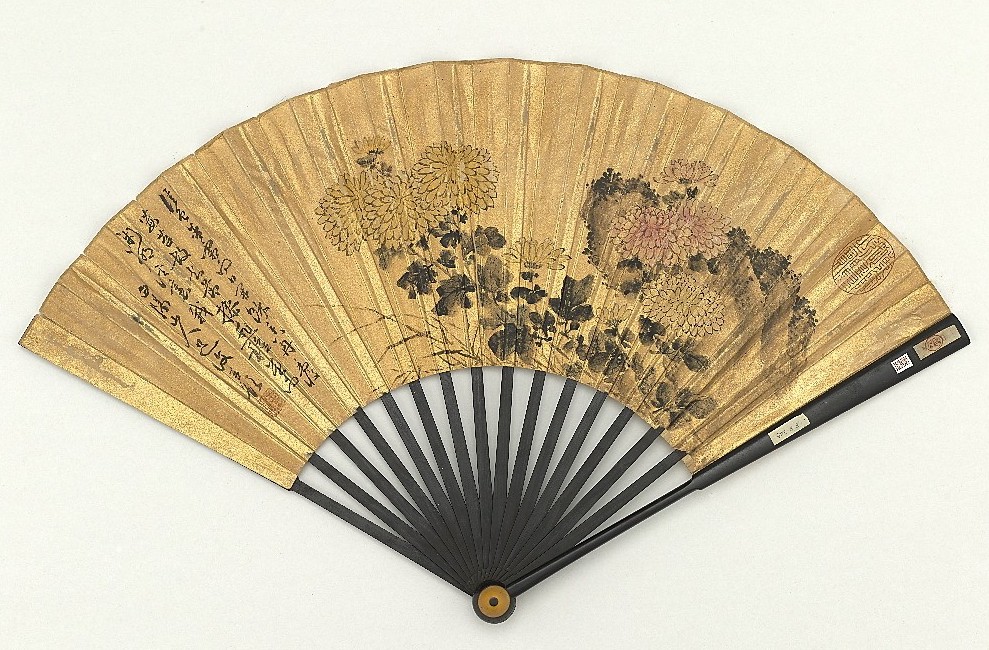
Ming Chen Chun's painting of chrysanthemums into a fan Collection of the National Palace Museum, Taipei
This painting has a self-inscription in cursive script by Chen Chun : A beautiful color with frost blooms to the sun, and the fragrance is covered with raspberry moss. Therefore, it is known that integrity is not one kind, and it was planted in Yuanming's path. Baiyangshan Humanity Complex.
Ming Xu Wei ammonite axis

Ming Xu Weiju Stone Scroll Collection of the Palace Museum, Taipei
Qing Dynasty Shitao Bamboo and Chrysanthemum Show Stone Chart Scroll

Qing Shitao Bamboo Chrysanthemum Show Stone Chart Scroll Collection of the Palace Museum
Shi Tao (1642-1707), surnamed Zhu, given name Ruoji, was from Quanzhou (now Quanxian), Guangxi, and descended from King Jingjiang of the Ming clan. When the Ming Dynasty died, he became a monk. He is best at painting landscapes, as well as flowers, bamboos and figures. The landscapes painted are green and vigorous, the style is novel, the brush and ink are dripping and hearty, the ink is thick and moist, the brushwork is elegant, the techniques are endlessly changing, and it is a unique family. He has made outstanding contributions to painting theory. He advocated that "brush and ink should adapt to the times" and "borrow the past to open up the present", emphasizing that there must be a real artistic feeling for nature, and that "I use my own methods" when creating art, and opposes the failure of the past to change.
Qing Shitao banana chrysanthemum shaft
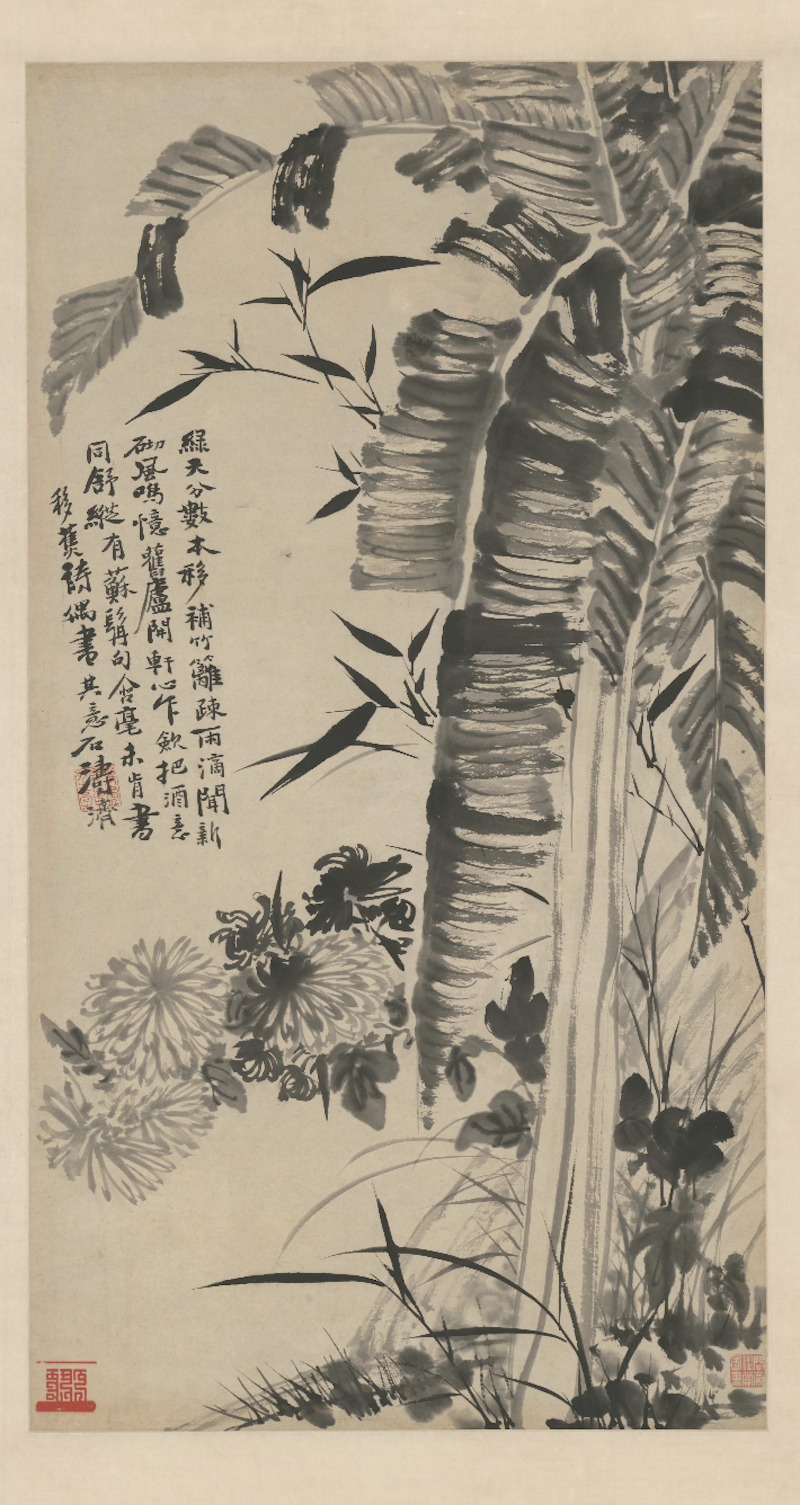
Qing Shitao Banana Chrysanthemum Scroll Collection of the Palace Museum
Qing Shitao on the chrysanthemum chart
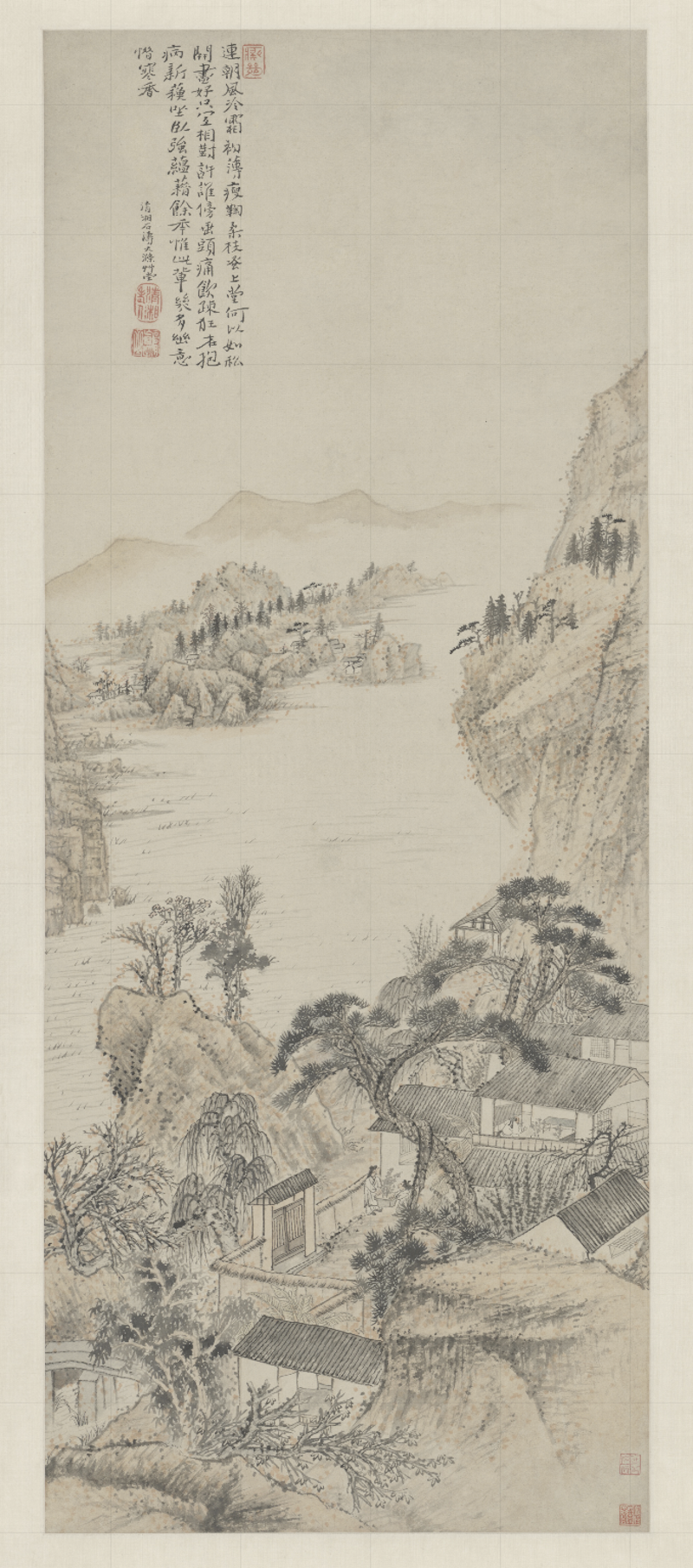
Qing Shitao to the Chrysanthemum Chart Scroll Collection of the Palace Museum
In the courtyard with double pines and qiu knots, plums and bamboos mirror each other, and the houses are scattered. Inside the house, Gao Shi watched the autumn chrysanthemum. Outside the courtyard are winding mountains and rivers from far and near, which add a bit of serenity to the seclusion of Gao Shi away from the world. This picture is different from Shi Tao's usual style of vigorous and unrestrained brushwork and free and easy painting. The painting is neat and delicate, or the brushwork of Xu or Ji, and the rhythm of the red dots and ink dots are full of boldness. This is a rare and delicate work created by Shi Tao when he lived in Yangzhou.
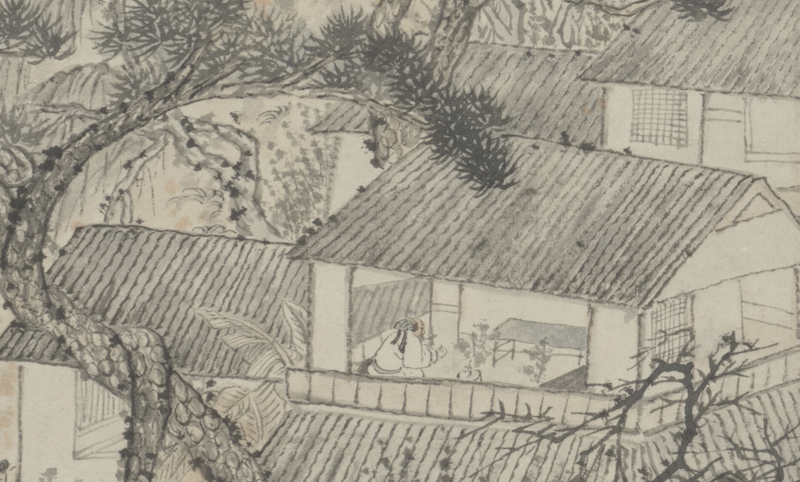
Qing Shitao's Scroll to Chrysanthemum (Part) Collection of the Palace Museum

Qing Shitao's Scroll to Chrysanthemum (Part) Collection of the Palace Museum
This painting is self-titled with a seven-character poem, inscribed "Qingxiang Shitao Dadi Thatched Cottage", with "Qingxiang Old Man" in Zhu Wenyin and "Gauze Blind Ziji" in white. The identification and collection are printed with two parties including "Tang Yun's Approval".
Qing Yun Shouping's sketchbook of chrysanthemum

Qing Yun Shouping's Sketchbook of Ink and Ink
Yun Shouping (1633-1690) was born in Wujin, Jiangsu. The initial name Ge, the word Shouping, later the word line, and the word Zhengshu, the number is Nantian, and the number is Dongyuan Caoyi. The poems are the first of the six Yi of Piling, and the paintings are related to the four kings of the early Qing Dynasty and Wu Li, collectively known as the four kings Wu Yun. He was good at painting landscapes, but later felt that he was unable to compete with Wang Hui, and specialized in flowers. He used Xu Chongsi's boneless method to participate in his own ideas and created his own style. He was the master of flower painting in the Qing Dynasty. This piece is the ninth piece of the "Sketch Book of Ink from Life", which depicts broken branches and chrysanthemums with an ink pen.
Yun Shou's parallel book is self-titled: Iron bones do not teach autumn colors, and they are covered in fragrant sweat. Shouping drama.
Qing Yun Shouping painted chrysanthemum scroll

Chrysanthemum scrolls painted by Shouping of Qing Dynasty in the collection of the National Palace Museum, Taipei
Yun Shou's self-titled in parallel regular script: The best seeds on the fence are secluded and clear, and the group flowers are pink and light. Indifferent than a high hermit, Taizhen Xizi tarnishes the name of the king. On the autumn day of Gengxu, the inscription of the grass clothes in Nantian was in the Ouxiang Pavilion.
Qing Jiang Ting Xiye chrysanthemum axis
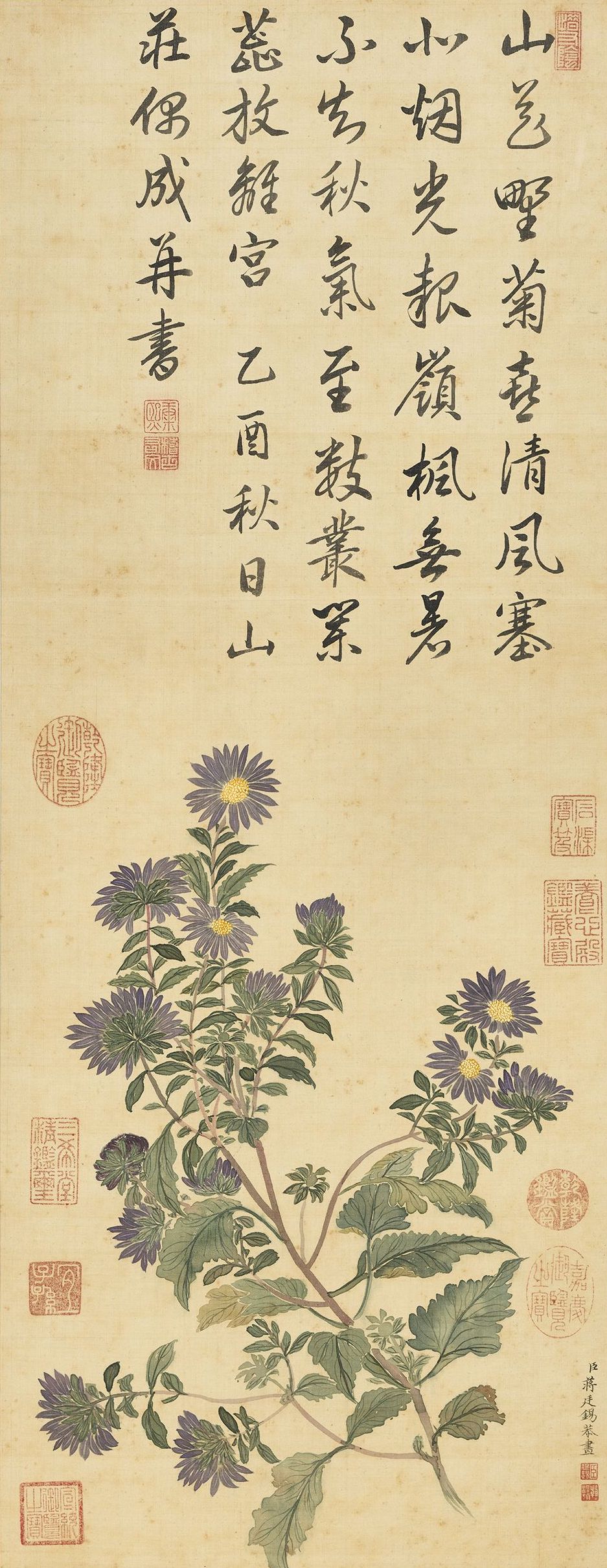
Qing Jiang Ting Xiye Chrysanthemum Scroll Collection of the Palace Museum, Taipei
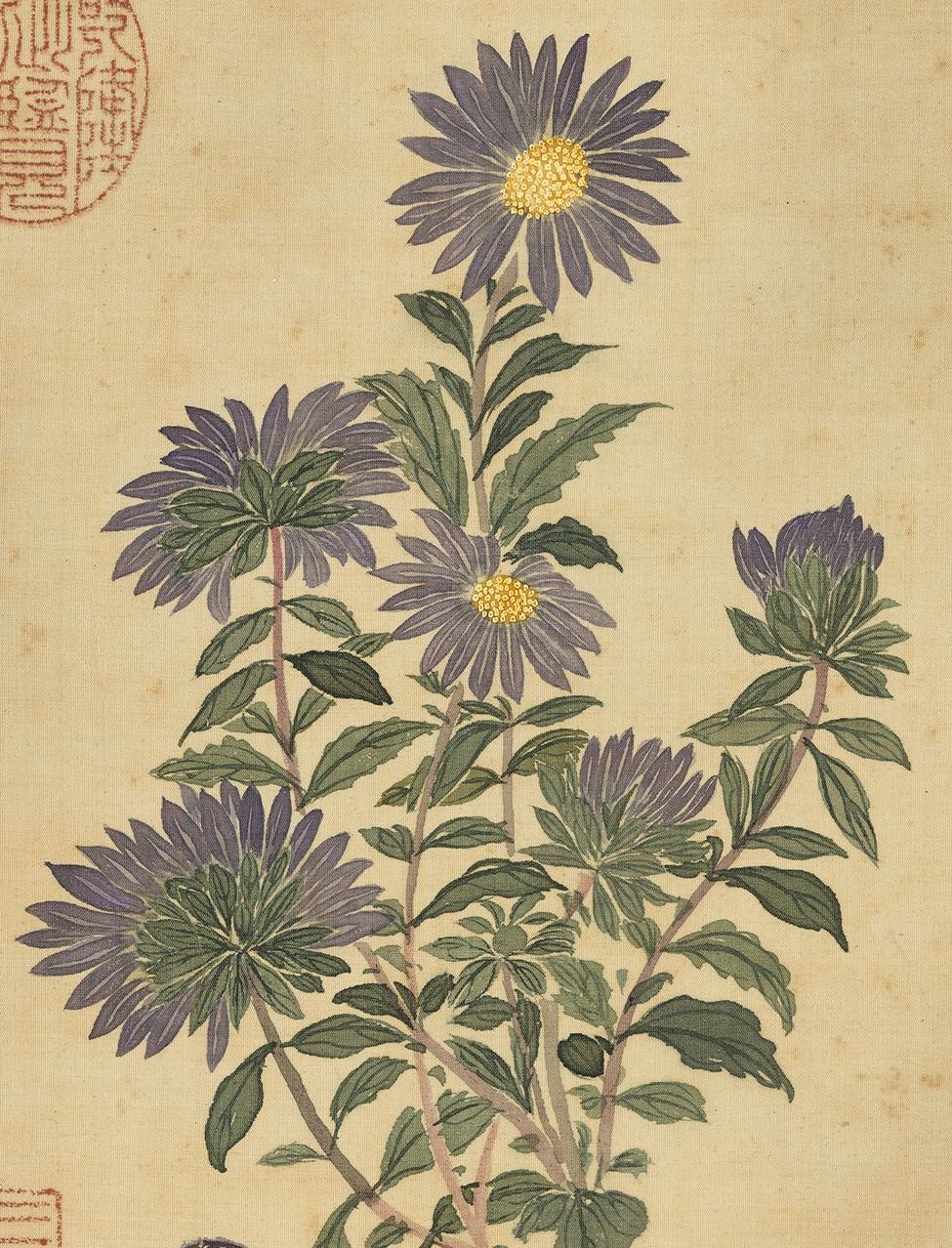
Qing Jiang Ting Xiye Chrysanthemum Scroll (part) Collection of the National Palace Museum, Taipei

Qing Jiang Ting Xiye Chrysanthemum Scroll (part) Collection of the National Palace Museum, Taipei
This painting has an imperial inscription in the running script of the Qing sage: "Mountain flowers and wild chrysanthemums like the breeze, and the smoky light in Saibei reports the ridge maple." When there is no heat, I don’t know the autumn air, and several Cong Lanrui are released from the palace. Yiyou (1705) Autumn Mountain Villa Occasionally formed and combined the book.
Qing Dynasty chrysanthemum into a fan

Qing Dynasty chrysanthemum fan collection of the National Palace Museum, Taipei
Qing people flower into fan

Qing Dynasty flowers into a fan Collection of the National Palace Museum, Taipei
Qingxu Gu bottle chrysanthemum chart axis

Qingxu Valley Chrysanthemum Chart Scroll Collection of the Palace Museum
This picture is a sketch of autumn chrysanthemum in a vase. The composition is ingenious and the setting is skillful. The scattered bottles and pots, and the "S"-shaped autumn chrysanthemum make the picture full of vitality and form a multi-level rhythm change. The colors are light and fresh, and the brushwork is flexible and skillful. It is Xugu's representative flower painting in his later years.
Qing Dynasty Wu Changshuo ink chrysanthemum scroll
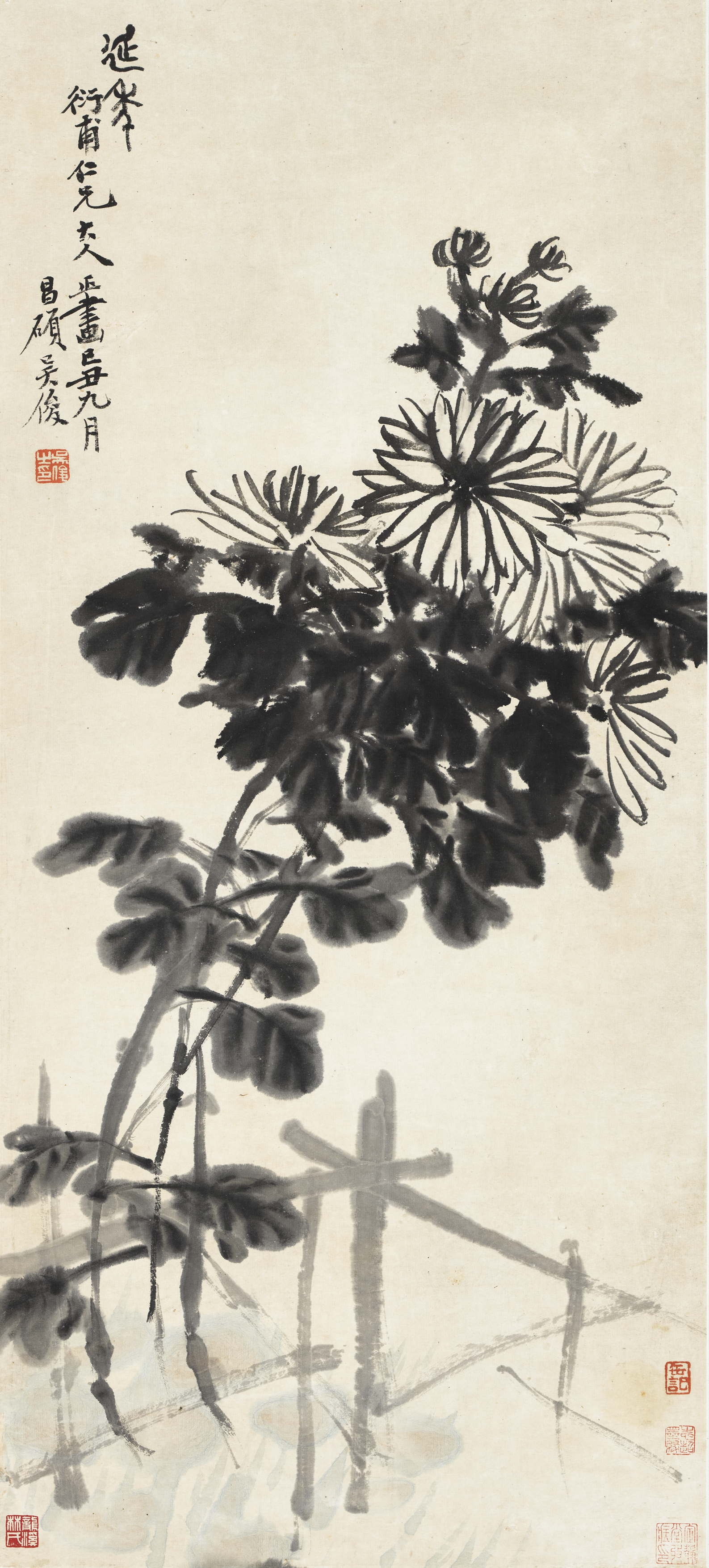
Qing Dynasty Wu Changshuo ink chrysanthemum scroll in the collection of the National Palace Museum, Taipei
Wu Changshuo (1844-1927) was born in Anji, Zhejiang. Formerly known as Jun, the word Changshuo, and the word Cangshi, the alias is Foulu, Kutie, and the department Pohe, Laofu, Dadea, after the age of seventy, the word line. Calligraphy is known for stone drum writing, and the brush is used to form the body, which is a change from the predecessors. The seal carving started from Zhejiang and Anhui, and traced back to the Qin and Han seals. , a giant of the Maritime School of Painting.
This painting was made by Yu Ji Chou and was made by Wu at the age of forty-six. Ink-painted chrysanthemum leaves stand out from the stand. The pen is full of energy, the ink color is moist and smooth, rich in gold and stone, and has a refreshing charm.
(This article is compiled from the relevant materials of the Palace Museum and Taipei Palace Museum.)
